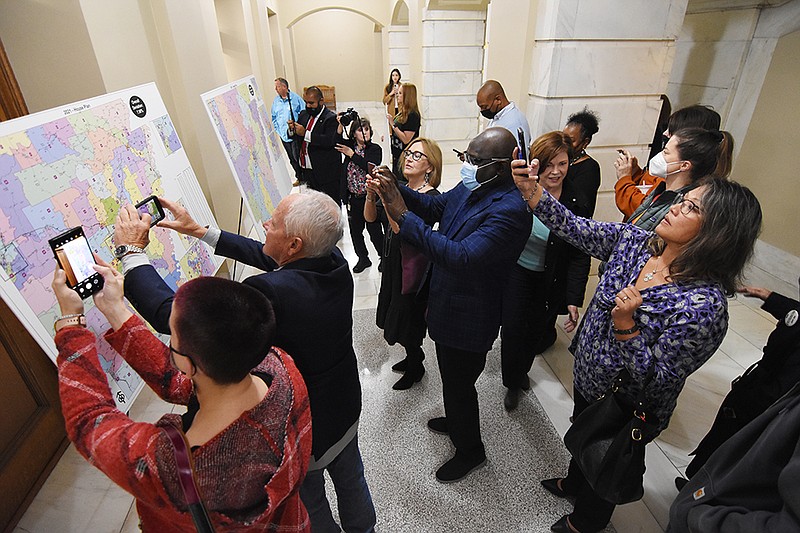New legislative district maps based on 2020 census data would create two new majority-minority districts, including Arkansas' first predominantly Hispanic district, and place three sitting lawmakers together.
The Arkansas Board of Apportionment, which is made up of Republicans Gov. Asa Hutchinson, Attorney General Leslie Rutledge and Secretary of State John Thurston, is responsible for redrawing the lines for state House and Senate districts each decade based on population changes.
Arkansas' population grew to 3,011,524 people over the past decade, making the ideal population for a state Senate district 86,044 and a House district 30,115. The new maps factor in population growth in Northwest Arkansas and Central Arkansas by adding seats in those regions while geographically expanding districts in the south and east.
The board voted to accept the new maps at a meeting Friday morning, kicking off a 30-day public comment period. The board is scheduled to reconvene Nov. 29 to incorporate feedback and make any technical adjustments before giving final approval.
After that, the maps become law Dec. 30, barring any legal barrier in the interim. The new districts will apply to lawmakers elected in 2022; the 100 House members and 35 senators take office in January 2023.
The new 52% Hispanic district encompasses eastern Springdale in Northwest Arkansas. The new maps also create a new district in eastern Pulaski County that is 51% Black, increasing the total number of majority-minority House districts from 11 to 13.
"This is historic in nature in terms of access and making sure that we continue equal access by all populations of our state," Hutchinson said.
But immigrant rights advocates from Northwest Arkansas had concerns, and much of the proposed House District 9, the majority-minority Hispanic district, draws from a current lawmaker's district without including her residence.
Rep. Megan Godfrey, D-Springdale, represents the current House District 89, which has the largest portion of minority voters of any existing House district. That was a factor she campaigned on.
[MAP: See the proposed state Senate districts » arkansasonline.com/2021arsenate/]
Godfrey speaks Spanish fluently, which she said at the time was a major factor in her election in 2018 because it helped her reach Spanish-speaking voters in her district and represent them. She defeated Republican incumbent Rep. Jeff Williams in that election to become Springdale's only Democratic delegation member.
"First of all, I'm very pleased there's going to be a majority Latino district," Godfrey said after the maps were released. "That's the important thing. They weren't split or diluted. I'm glad they're being recognized."
Godfrey's new district, according to the proposed maps, goes from downtown Springdale into Hickory Creek in Benton County. Much of her present district in east Springdale would go into House District 9.
"I am surprised to be losing so many voters who meant so much to me," she said.
Asked if she would run again, Godfrey said she has not decided yet but "will be supporting the Democratic candidate in District 9."
Immigrants' rights advocate and former state House candidate Irvin Camacho of Springdale said it appears the new majority Hispanic district proposed would not divide Hispanics from the immigrant Marshallese population in the city, but it is hard to tell.
"Megan has been such a good representative for us that it's disappointing to see her moved out," Camacho said of Godfrey.
The move also came with little warning, he said.
Mireya Reith, director of the Springdale-based immigrant rights group Arkansas United, said gaining a majority Hispanic district in Springdale may have been offset, at least somewhat, by losses elsewhere.
"We're gravely concerned that a majority Black-brown district in northside Fort Smith may have been changed," she said.
The group has similar concerns about predominantly Black districts in southwest Little Rock, she said.
Arkansas United teamed up with the census participation encouragement group Arkansas Counts last year to increase participation in the U.S. census by immigrants, who are historically undercounted in those efforts, according to the U.S. Census Bureau.
[MAP: See the proposed state House districts » arkansasonline.com/2021arhouse/]
"This is why Arkansas United cooperated with Arkansas Counts, so immigrants would be reflected in the democratic process," Reith said in a phone interview about the first majority Hispanic state House district. "This is what we've been lobbying for for over a decade."
She also noted that the state Board of Apportionment posted materials on its website in Spanish, which the group had requested.
But if the board wants meaningful public comment, it needs to provide more detailed maps, Reith said. The available maps are too general to see what neighborhoods and other regions are specifically affected, she said.
"If they want feedback we need better maps," she said.
Her group and others have asked for a meeting with board staff members to discuss that topic, she said.
In a statement Friday, the American Civil Liberties Union of Arkansas cautioned that the new maps "may not fairly represent all Arkansans" and urged the board to make its review process more accessible and transparent.
"Too often and in too many places, many politicians have abused the districting process to manipulate the outcome of elections," Holly Dickson, ACLU of Arkansas executive director, said. "We must demand maps that are representative of all Arkansans, not ones that dilute the political power of Arkansas' minority populations -- and violate the Voting Rights Act of 1965."
Dickson said the organization urges all Arkansans to review the maps for impact on their community and make their voices heard.
ACLU attorneys and NAACP partners will analyze the new maps in accordance with criteria from the U.S. Constitution and the Voting Rights Act of 1965 "to ensure they do not carve up communities and significantly underrepresent populations that are traditionally ignored."
"All people should have the opportunity to be equally represented -- this should be a nonpartisan issue. Representative maps are fundamental to ensure that every vote counts, and serve as the foundation of systemic equality for Black and brown residents," Dianne Curry, Little Rock NAACP president, said in a statement.
The number of majority-minority districts in the Senate remained the same at four.
State Rep. Jim Dotson, R-Bentonville, confirmed Thursday that he plans to run for a new, open Senate seat in north-central Benton County if the new border there is approved.
"As of this moment it is full speed ahead," he said.
Proposed Senate District 34 stretches from Centerton and northern Bentonville to the Missouri border.
[Gallery not loading above? Click here for more photos » arkansasonline.com/1030apportionment/]
No sitting senators are pitted against one another by the proposed districts, but one new House district in eastern Arkansas puts three sitting representatives together: Rep. Reginald Murdock, D-Marianna, Rep. Mark McElroy, R-Tillar, and David Tollett, R-Lexa.
The new District 62 includes all of Lee and Phillips counties as well as parts of St. Francis, Monroe, Arkansas and Desha counties.
Murdock, whose district includes parts of Lee and St. Francis counties, remains in a majority-minority district.
"I'm the only minority candidate. Just by that data point, you would say that it favors me," Murdock, who is Black, said.
Though he said his new district is "probably the largest land mass district in the state," Murdock said he is familiar with the populations of the counties that he doesn't currently represent and feels he could win the race and represent them well.
Murdock is running for reelection, while McElroy and Tollett said they are unsure.
McElroy, who has previously served as a Democrat and an independent, said the new district doesn't give him "any advantage."
"Seems like somebody didn't want me around much," he said.
The proposed lines put McElroy's home in Desha County near the southern edge of the new District 62, and he said he would need to look more closely to see whether he could win.
McElroy said it was "kind of ridiculous to put three incumbents in the same place," and he felt he could have been put in a district that included parts of Chicot, Drew or Ashley counties. But he wasn't surprised to be pitted against other sitting representatives.
"I'd been expecting that, of course, we lost a lot of population in southeast Arkansas," he said.
Tollett also attributed the new map to population loss in the Delta, but called the new district "a blatant attempt to eliminate representation for minority districts in the Arkansas Delta" by lumping three House members together. He said the southern part of the district dips into a very rural area.
"I've never heard of another scenario where three state representatives were placed into the same district after the maps were redrawn," he said.
To view the maps and make public comments, visit arkansasredistricting.org.



